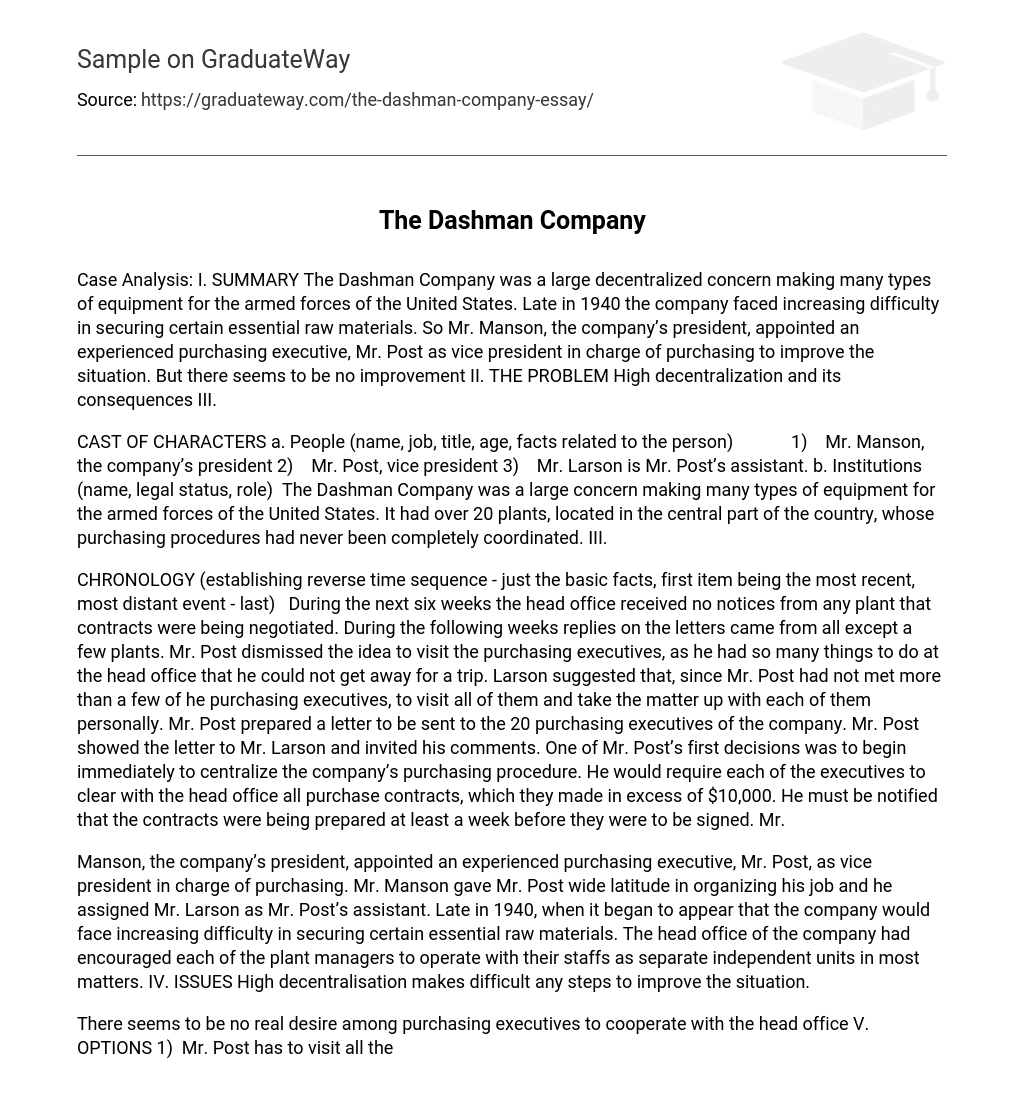Case Analysis: I. SUMMARY The Dashman Company was a large decentralized concern making many types of equipment for the armed forces of the United States. Late in 1940 the company faced increasing difficulty in securing certain essential raw materials. So Mr. Manson, the company’s president, appointed an experienced purchasing executive, Mr. Post as vice president in charge of purchasing to improve the situation. But there seems to be no improvement II. THE PROBLEM High decentralization and its consequences III.
CAST OF CHARACTERS a. People (name, job, title, age, facts related to the person) 1) Mr. Manson, the company’s president 2) Mr. Post, vice president 3) Mr. Larson is Mr. Post’s assistant. b. Institutions (name, legal status, role) The Dashman Company was a large concern making many types of equipment for the armed forces of the United States. It had over 20 plants, located in the central part of the country, whose purchasing procedures had never been completely coordinated. III.
CHRONOLOGY (establishing reverse time sequence – just the basic facts, first item being the most recent, most distant event – last) During the next six weeks the head office received no notices from any plant that contracts were being negotiated. During the following weeks replies on the letters came from all except a few plants. Mr. Post dismissed the idea to visit the purchasing executives, as he had so many things to do at the head office that he could not get away for a trip. Larson suggested that, since Mr. Post had not met more than a few of he purchasing executives, to visit all of them and take the matter up with each of them personally. Mr. Post prepared a letter to be sent to the 20 purchasing executives of the company. Mr. Post showed the letter to Mr. Larson and invited his comments. One of Mr. Post’s first decisions was to begin immediately to centralize the company’s purchasing procedure. He would require each of the executives to clear with the head office all purchase contracts, which they made in excess of $10,000. He must be notified that the contracts were being prepared at least a week before they were to be signed. Mr.
Manson, the company’s president, appointed an experienced purchasing executive, Mr. Post, as vice president in charge of purchasing. Mr. Manson gave Mr. Post wide latitude in organizing his job and he assigned Mr. Larson as Mr. Post’s assistant. Late in 1940, when it began to appear that the company would face increasing difficulty in securing certain essential raw materials. The head office of the company had encouraged each of the plant managers to operate with their staffs as separate independent units in most matters. IV. ISSUES High decentralisation makes difficult any steps to improve the situation.
There seems to be no real desire among purchasing executives to cooperate with the head office V. OPTIONS 1) Mr. Post has to visit all the purchasing executives and take the matter up with each of them personally. While Mr. Larson will look after everything in the head office and will send the letters a. Advantages The process of centralisation will be more intensive b. Disadvantages Mr. Post had so many things to do at the head office that he could not get away for a 2) to send Mr. Post’s assistant visit all the purchasing executives and take the matter up with each of them a.
Advantages (2-3) 1) The Head office will work properly with Mr. Post and Mr. Larson will do all his best to take the matter up 2) Mr. Larson will gain a great experience 3) Mr. Post will take under his control in the head office b. Disadvantages (not less, balanced to the advantages) 1) There might be probability that the purchasing executives will not listen Mr. Larson 2) The plants are busy, the usual routines for that time of year is being followed. VII. RECOMMENDATION The most reasonable course of action is to send Mr.
Post’s assistant visit all the purchasing executives and take the matter up with each of them. Because all other executives are not reliable and maybe not interested in the company’s centralization. VIII. PLAN OF ACTION a. To send Mr. Larson to meet all the purchasing executives and take the matter up with each of them. b. To explain all the purchasing executives the difficulty of the situation and to take all the essential measures which were pointed out in the letter c. Mr. Post should do all his best in the head office may be to send letters twice.





